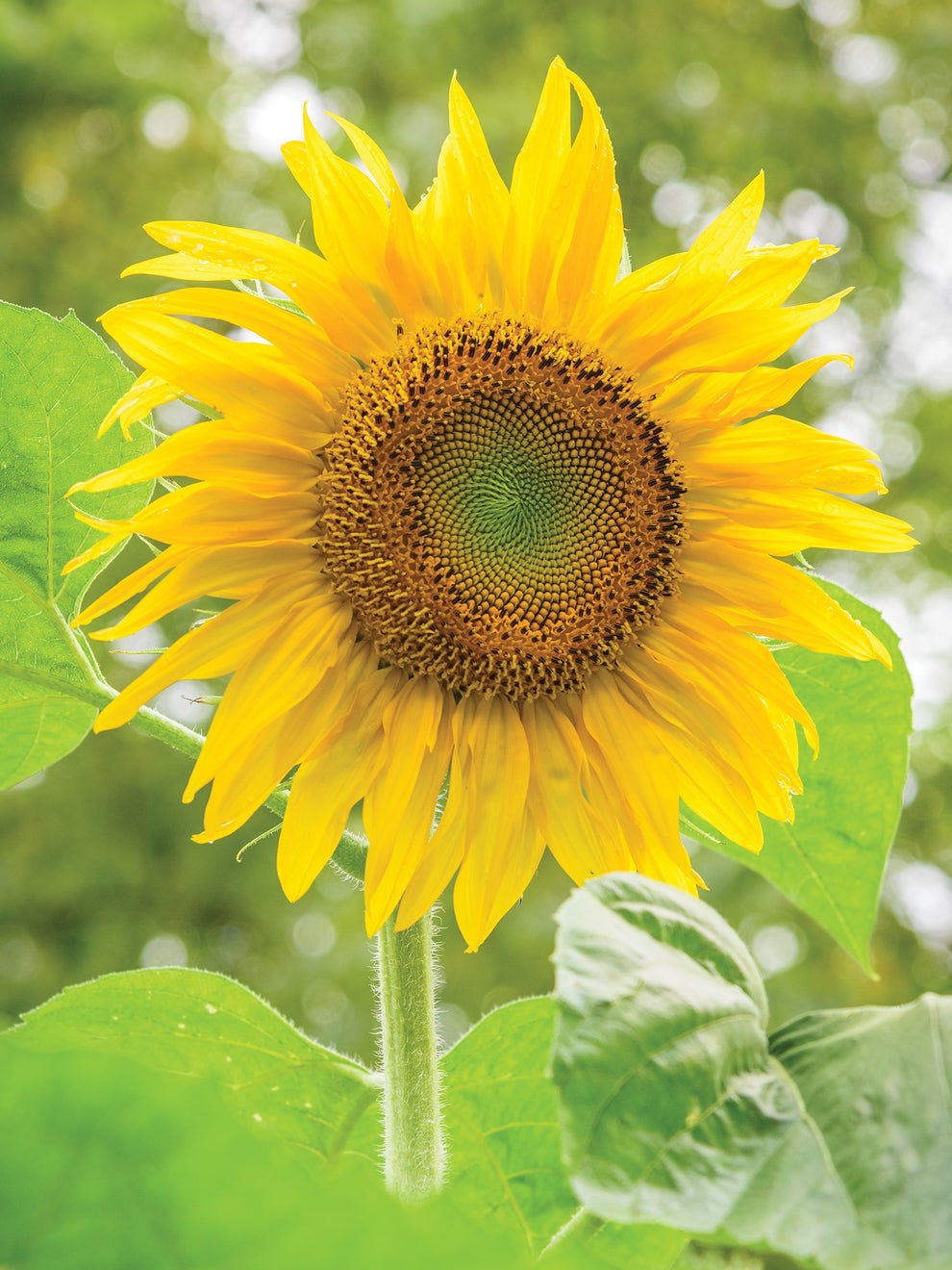
Sunflowers: With bright blooms that go all summer, sunflowers are heat-tolerant, resistant to pests, and attractive to pollinators. Harvest the seeds in late summer and fall for a healthy snack or for the birds! Learn how to plant, grow, and care for sunflowers. About Sunflowers
The sunflower (Helianthus annuus) is an annual plant with a sizeable daisy-like flower face. Its scientific name comes from the Greek words helios (“sun”) and anthos (“flower”). The flowers come in many colors (yellow, red, orange, maroon, brown), but they are commonly bright yellow with brown centers that ripen into heavy heads filled with seeds. Sunflowers make excellent cut flowers, and many attract bees, birds, and butterflies.
Sunflowers are heliotropic, which means that they turn their flowers to follow the movement of the Sun across the sky from east to west and then return at night to face the east, ready again for the morning sun. Heliotropism happens during the earlier stages before the flower grows heavy with seeds.
There are tons of varieties of sunflowers available today, so there’s bound to be one that fits your garden. Choose between those with branching stems or single stems, those that produce ample pollen for pollinators or are pollen-free (best for bouquets), those that stay small or tower above the rest of the garden, or those that produce edible seeds! Learn why you should start growing these happy flowers in your garden.
For more information on how to grow sunflowers click the following hyperlink to Farmers Almanac Sunflowers link.
Helianthus annuus (Common Sunflower): Common Sunflower is and annual in the Asteraceae (daisy) family. It's commonly seen growing along roads, fences, fields, and in waste areas west of the Mississippi River and is the state flower of Kansas. Hybridization has produced many cultivars, expanding the range of flowers from the common yellow to red, mahogany, bronze, white and bi-colors. This plant is grown commercially as food for birds, livestock and humans. Steamed buds have an artichoke flavor.

Helianthus angustifolius (Narrow Leaf Sunflower): Swamp sunflower is a native perennial member of the aster family and can be found from NY to FL to TX. It is a large perennial that can grow up to 8 feet tall with showy yellow daisy-like flowers from mid to late summer into fall. Prune plants back in June to encourage branching. It prefers moist to occasionally wet acidic sandy to clay loams in full sun. It can be grown on drier soils if adequate moisture is provided. It will tolerate part shade but flowers better in full sun. This plant is a favorite of pollinators and songbirds. There are shorter cultivars available if desired. Use this plant in the back border of a native/pollinator garden, naturalized area, or along streams and ponds. Give it room to grow and spread and you will have a profusion of late-season flowers when little else is blooming. This plant was selected as the 2007 NC Wildflower of the Year, a program managed by the North Carolina Botanical Garden with some financial support from the Garden Club of North Carolina.

Helianthus atrorubens (Appalachian Sunflower): Sunflower is a herbaceous perennial that may grow 3 to 5 feet tall. The leaves are opposite with a smooth margin. White hairs extend down the margin of the leaves. The stem is coarsely hairy. Large, yellow flowers with a brown center first mature in mid-summer and continue into late fall. Helianthus atrorubens is found in rocky, clay or sandy soils of woodlands and along road banks. It excels in open woodland gardens, cottage gardens, and mixed perennial beds and attracts bees, butterflies. Woodland birds collect the seed.
Helianthus decapetalus (Forest Sunflower): Ten-Petal Sunflower is a rhizomatous perennial wildflower in the aster family that is native to eastern and central North America and is found in woodlands and forests. It is found in all areas of NC but is more prevalent in the Piedmont and mountains. It is a high-value wildlife plant providing food for pollinators, birds and mammals. The bright yellow flowers are up to 3 inches across and bloom from July to Oct. It can spread aggressively in the right conditions. This plant prefers full sun to partial shade in moist, loamy, well-drained soils. Use this plant in a naturalized area, woodland edge or meadow. Great for naturalizing.

Helianthus divaricatus (Rough Sunflower): Woodland Sunflower, is a native herbaceous perennial in the aster family that can grow 5 to 7 feet tall. It is native to eastern and central North America and is found in all areas of NC in rocky or sandy woodlands and dry open sites. The leaves are opposite with a smooth to slightly toothed margin and hairy underside. The leaves often have no stem. Large, yellow flowers first mature in early summer and continue into early fall. Woodland Sunflower is easy to grow in average well-drained soils in partial shade. It is tolerant of a wide range of soil types. Use in the native/pollinator garden, naturalized area or woodland garden. It is drought tolerant once established. It is a high-value wildlife plant. Insects, Diseases, or Other Plant Problems: Taller plants may need staking.

Helianthus maximiliani (Maximilian Sunflower): Helianthus maximiliani is a prairie sunflower named after Prince Maxmilian of Germany, a naturalist who lead an expedition to the West from 1832 to 1834. The Maxmillian Sunflower prefers moist, clay-like soil but is tolerant of a wide variety of soils. It is easily grown from seed and taller plants may benefit from staking.
Helianthus microcephalus (Small-headed Sunflower): Small Woodland Sunflower is a native wildflower in the aster family found in dry woodland areas or along roadsides in the eastern U.S.A. In NC it is found in all areas but primarily in the Piedmont and mountain regions. It will grow 4-6 feet tall and 2-4 feet wide. The yellow flowers are showy in clusters with a long bloom season. Pollinators are attracted to the blooms and birds will eat the seeds. It spreads by rhizomes and reseeding. Small Woodland Sunflower is easy to grow in average well-drained soils and tolerates moist to occasionally dry soil and full sun to partial shade. It is drought tolerant once established. Deadhead the blooms to stimulate reblooming and prevent unwanted seeding. Divide plants as needed to control growth. This plant is suitable for cottage gardens, naturalized and native gardens and rock gardens. It makes a great nectar plant for a butterfly garden as well.

Helianthus occidentalis (Fewleaf Sunflower): Naked-stem Sunflower is a native herbaceous perennial wildflower found along rocky or sandy riparian areas. Easy to identify in the wild by the rosette of stalked, basal leaves, 1 1/2 inches across around the base of the plant's 2 to 4 foot stalk and one to four pairs of small, widely spaced, stalkless leaves on the stem. The blades of basal leaves usually have rounded bottom and blunt tips. Their upper blade surfaces are medium green and rough-textured, while their lower surfaces are light green. In addition to their central veins, the basal leaves have 1 to 2 pairs of lateral veins that originate from the bases of their blades. The slender petioles of the basal leaves are 1 to 4 inches long and light green. The flowering stalk is light green to greenish red and glabrous to hairy, mostly naked, except for 1 to 2 pairs of opposite leaves below and a few alternate leaves above. The blades of opposite or alternate leaves are 1 to 3 inches long and 1/4 to 3/4 of an inch across, lanceolate or elliptic in shape and usually smooth (entire) along their margins. The blades surfaces of these leaves are similar to those of the basal leaves, while their petioles are either absent or up to a 1/2 inch long. The flowering stalk terminates in 1 to 12 flower heads. Individual flower heads are 1 1/2 to 2 1/2 inches across, consisting of 8 to 22 ray florets that surround numerous disk florets. The petaloid rays are yellow and oblong to elliptic in shape. The tiny disk florets have tubular corollas that are yellow and 5-lobed. Around the base of each flower head, there are several overlapping floral bracts. The root system is a narrow taproot with shallow rhizomes that sometimes form vegetative colonies. Plants should be divided every 3 or 4 years to control spread and maintain vigor. The plant prefers full sun, average dry to medium conditions, and well-drained soil. This wildflower will tolerate partial sun and a wide range of soils, from clay to sand; however, clay soil will need to be amended. On deep fertile soil, it is not competitive with other species of plants and is one of the less aggressive Helianthus spp. (sunflowers). The genus name is from the Greek helios meaning sun and anthos meaning flower. The species name means west in the sense that North America is west of Europe and not that the plant is native to the west.

Helianthus resinosus (Resindot Sunflower): Resinous Sunflower is an herbaceous perennial wildflower native to several southeastern states. It nature, it can be found growing along roadsides, in pine woodlands, mixed hardwood forests, and thickets. Each stem can grow up to 8 feet in height and will produce 1 to 5 flower heads. Each head has 10 to 20 yellow ray petals which are the outer larger petals and over 90 yellow disc flowers, which are the tiny innermost flowers. This sunflower is noted for the abundant yellow resin dots or glands on the leaves and flower heads. This plant is native to North Carolina and prefers full sun to partial shade and soil of average moisture. However, it does tolerate dry soil and soils of most texture, including clay. It is self-seeding and you can easily expand your garden with this large perennial for years. It will also multiply by underground suckers. The suckers can be shared with other gardeners. Once they have become established, a small trowel can be used to dig them up. Pot them and give them time to establish a root system before replanting. Of course, the ease with which it spreads can make it a problem to keep under control. This plant is sometimes mistakenly sold under the name Helianthus Tomentosus Michaux.
Helianthus schweinitzii (Schweinitz's Sunflower): Schweinitz's Sunflower is a native herbaceous wildflower in the aster family. In nature it is found in the clay soils of woodlands, forest openings, grasslands, and along roadsides in the Piedmont areas of North and South Carolina. Once endemic to these areas, it is now listed as an endangered species by federal and North Carolina state agencies. This plant is one of the rarest species of sunflower in the United States and is not recommended for home landscapes. This plant grows best in well drained soil with full sun. However, it does tolerate sandy and clay soils as well as dry soils. It does not do well in full shade. The plant has tuberous roots and can spread quickly. No known diseases or insect pests. This plant spreads by tuberous roots and grow out of control.
Desire Red Hybrid Sunflower Seeds:
Description: A truly sophisticated sunflower with striking stems and veins. Prepare to be seduced by a sunflower. ‘Desire Red’ is everything you’ve dreamed of—or couldn’t even imagine. Bold wine-red petals circle a deep-burgundy center, with dramatically matching stems and veins. Dwarf 24–38" plants are equally suited to tight borders and containers. The enchanting colors arrive early and continue well into autumn, much to the delight of pollinators. 2023 gold medal Fleuroselect winner.

Description: Sophisticated sunflower with fluffy, caramelized sugar color. Bound to be the sweetest, most sophisticated sunflower on your block. Elegant crowns of golden-yellow petals surround fluffy, amber-bronze centers – a floral reflection of the caramelized sugar atop dessert classic ‘crème brûlée’. Refined plants stand 4-5’ tall with a bushy, branching habit and a continuous bounty of blooms. If you’re craving something new and spectacular for your border, this sunflower is for you.
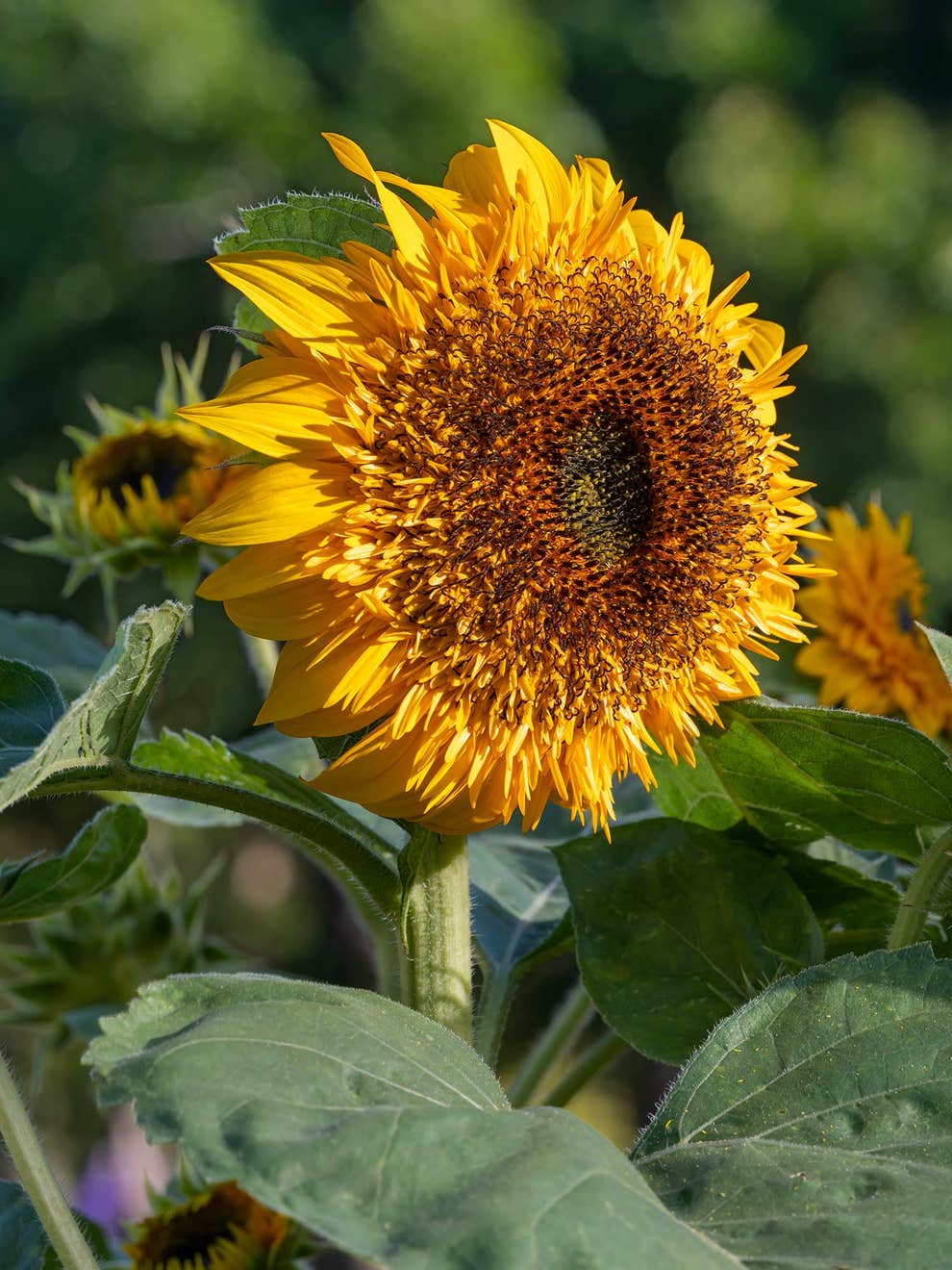
Tiger Eye Hybrid Sunflower Seeds:
Description: Fantastic for containers on a porch or patio, too. Rejoice, sunflower lovers! Our radiant new bicolor beauties have it all, for garden, vase, and happy bees, butterflies, and other pollinators. Enjoy a bounty of up to eight 5-inch blooms per plant — you’ll get armloads of bright bouquets. The blooming plants look balanced rather than top-heavy, thanks to a sturdy branching habit. Their shorter stature makes harvesting easy. They’d be fantastic for containers on a porch or patio, too.

Description: HEIRLOOM. Enormous organic sunflower. Towering heirloom is one of the oldest, most beloved sunflower varieties. Sky-high 12 plants with huge heads are supported by great, sturdy trunks. Ready to attract pollinators and turn heads in the neighborhood. Roast grey-striped seeds for snacking or feeding wildlife throughout winter.

Sunray Yellow Hybrid Sunflower Seeds:
Description: Uniquely dwarf plants branch out to bear up to fourteen flowers each. Small plants—big smiles! Uniquely dwarf plants branch out to bear up to fourteen 4" flowers each. The fun of sunflowers without the towering height. So easy to grow from seed, we suggest you plant in succession to have flowers all summer! Every garden, big or small, has room for this sunflower in patio containers or beds and borders.
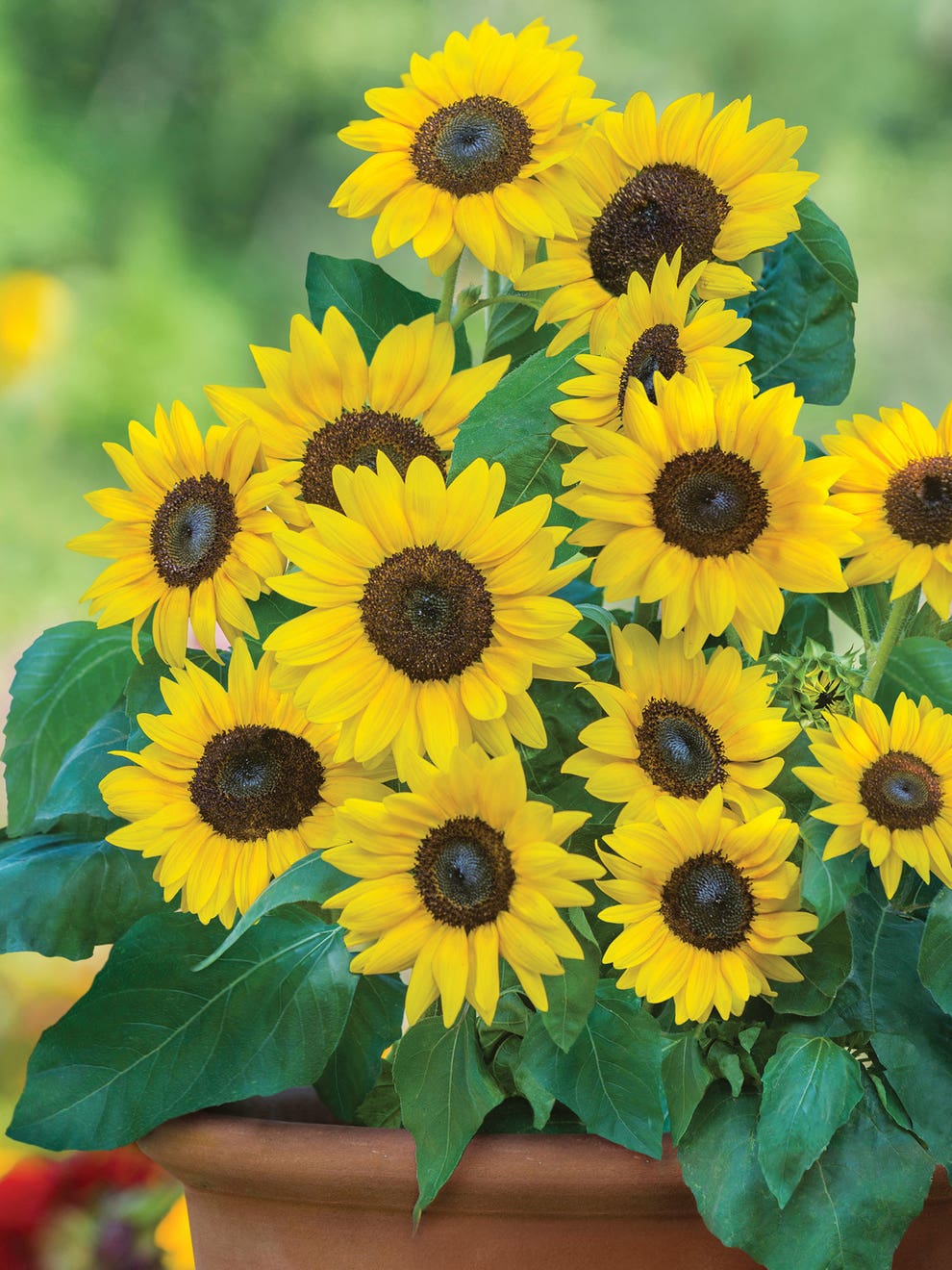
Chianti Hybrid Sunflower Seeds:
Description: Stunning wine-red velvet petals flecked with gold. The deepest red sunflower! Wine-red velvet petals are flecked with gold. Flowers are 3-4" across on 4-5 ft. plants. Multiple branched and purple-stemmed, its dramatic in the garden. Pollen less, so its good for cutting, too.
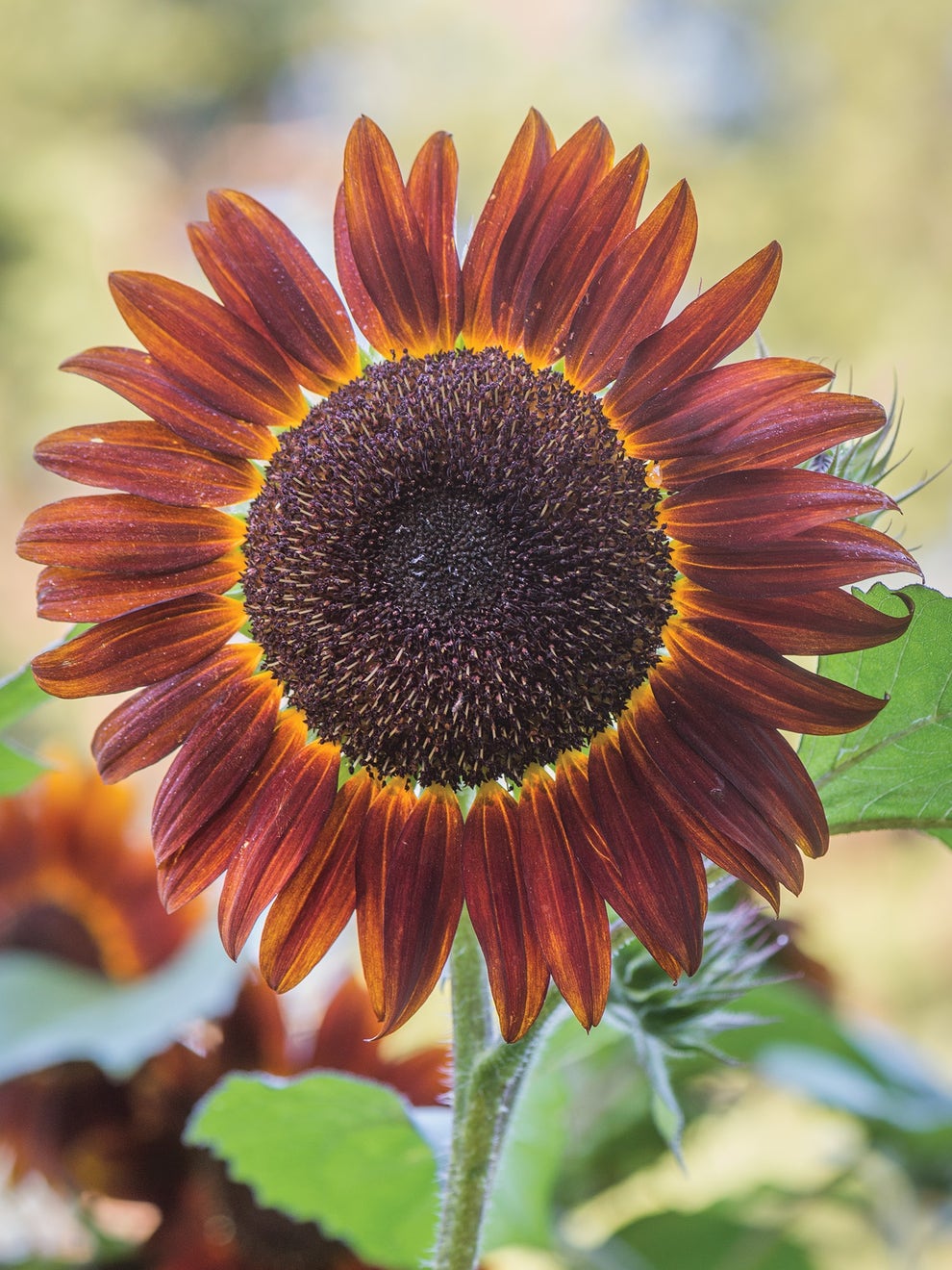
Sunforest Mix Sunflower Seeds:
Description: Make an instant forest with gigantic sunflowers. Plant a fast growing sunflower forest where your kids can frolic. Our blend of three tall and sturdy varieties becomes an enchanted natural playground. Their blooms are large (at least 1' across), and their stalks are tall (between 10-15'). Grow a big block in the backyard, leaving 3' or 4' wide pathways leading to the secret play area in the middle of the sun forest garden. Your children will have a summer full of memories to last a lifetime.

Jua Maya Hybrid Sunflower Seeds:
Description: Nice clean plants that develop flower heads very fast. From seed to vase time is from 45 to 50 days. We are knocked out by this gorgeous, picture-perfect, vase-ready sunflower with deep golden yellow flowers circling a pure black center. A pollen free hybrid, the fast-growing plants - 45 days from seed to vase - can be sown three times in a single summer.

Super Snack Mix Hybrid Sunflower Seeds:
Description: This sunflower produces the easiest seed to crack for snacks and they're huge. This sunflower produces the easiest seed to crack for snacks and they're huge. The plants are only 5 ft. tall and produce a single medium-sized (10") flower. The color pattern is classic yellow-gold with dark centers. Attracts butterflies.
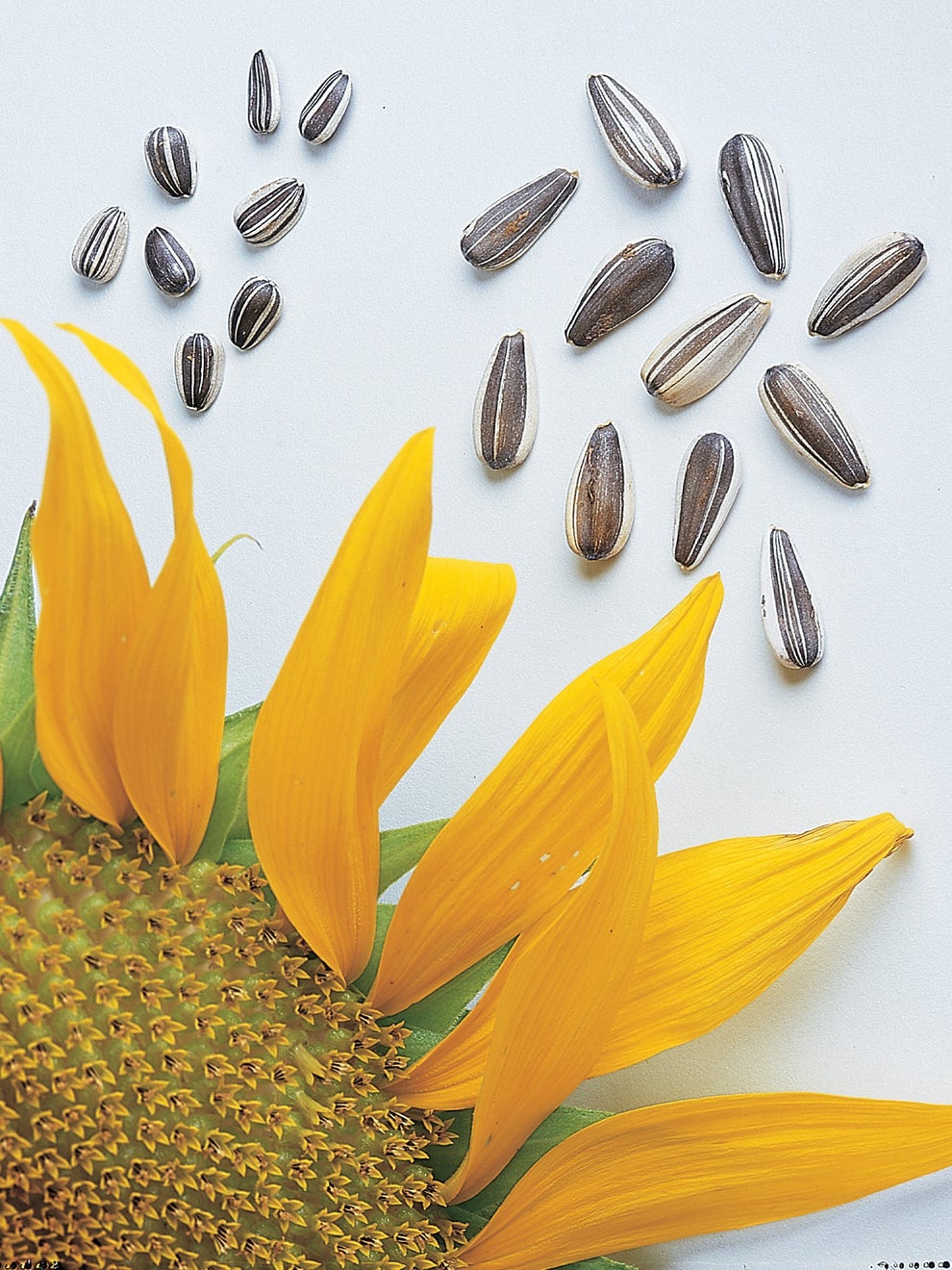
Description: Cheerful flowers can be planted close together to create a bustling display. Delight for bees and bee-lovers alike! A ring of golden petals orbit their dark centers of 5-7" flowers. When ‘Busy Bees’ are planted close together, they bustle with buzzing pollinators. Cheerful in the garden, boldly beautiful in arrangements, or a thanksgiving feast for birds when left on the stalk.

Description: Fast-growing giant. The most stunning of our giant sunflowers, with sturdy stems and lush leaves. It forms a massive wall of foliage topped off with extra large, perfectly round 10" golden flowers. Rapid growth from seed to maturity by mid-summer.
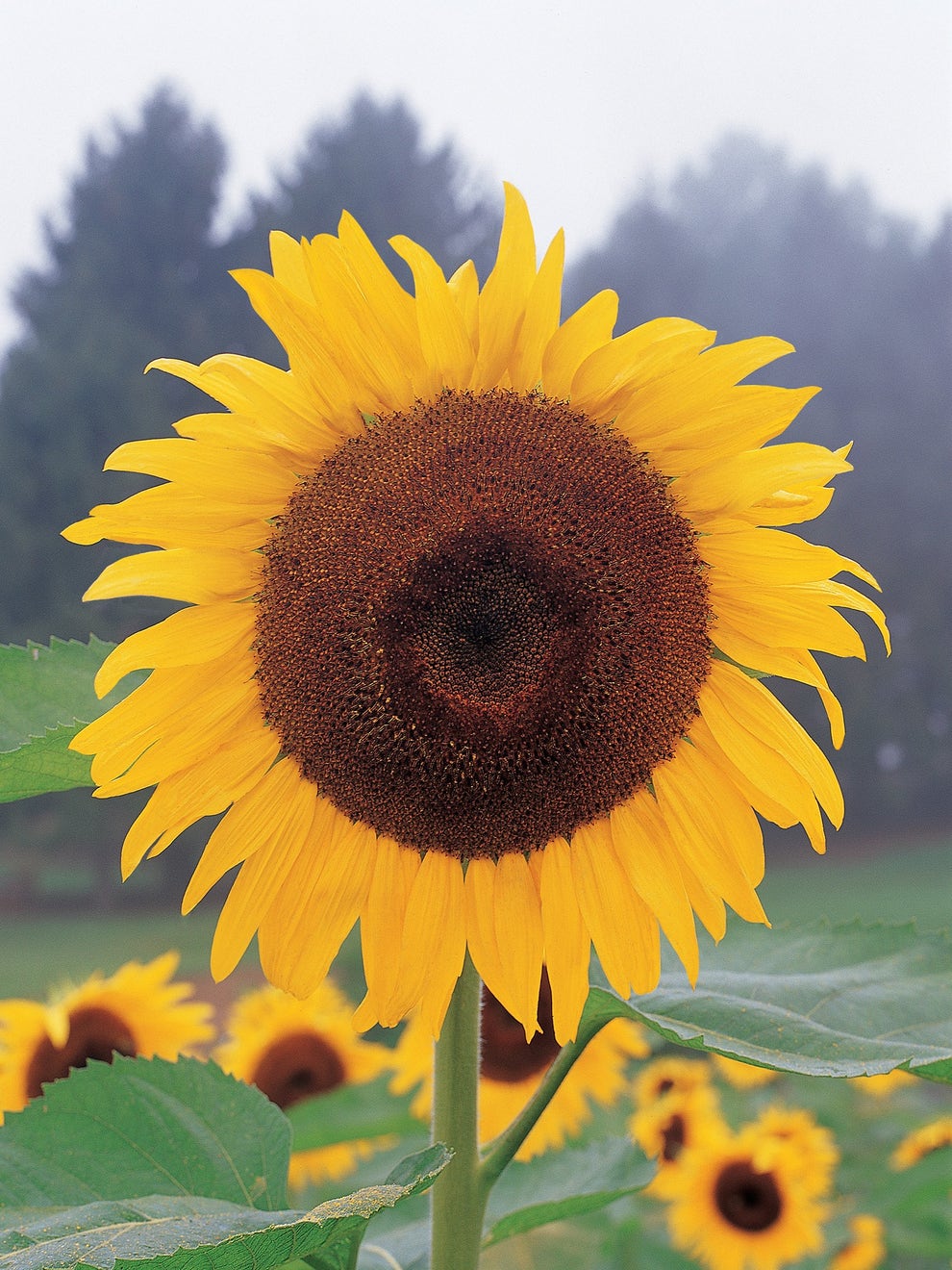
Sunfinity Hybrid Sunflower Seeds:
Description: Infinite beauty from fast-growing plants. Infinite beauty from plants that grow so quickly, your garden or patio will be filled with sensational sunny color 3-4" blooms before you know it! Spectacular as a cut flower, too. For best branching, pinch off the main stem above the fourth or fifth pair of leaves as it’s growing. Plants won’t set seed and are disease-resistant.

Lemon Queen Organic Sunflower Seeds:
Description: Organic tall sunflowers. A prolific sunflower, with unique pointed petals in lemon-yellow with chocolate brown centers, to 4-5" across. Plants are multibranched, up to 6 ft. tall. Plant with taller or shorter sunflowers with darker blooms for dramatic contrast. Sunflower seeds grow best when sown in well-drained soils. Sow seeds 1 1/2-2" deep, spaced 12" apart. Plant every 2-4 weeks for extended bloom. 90 days. Certified Organic Seed.
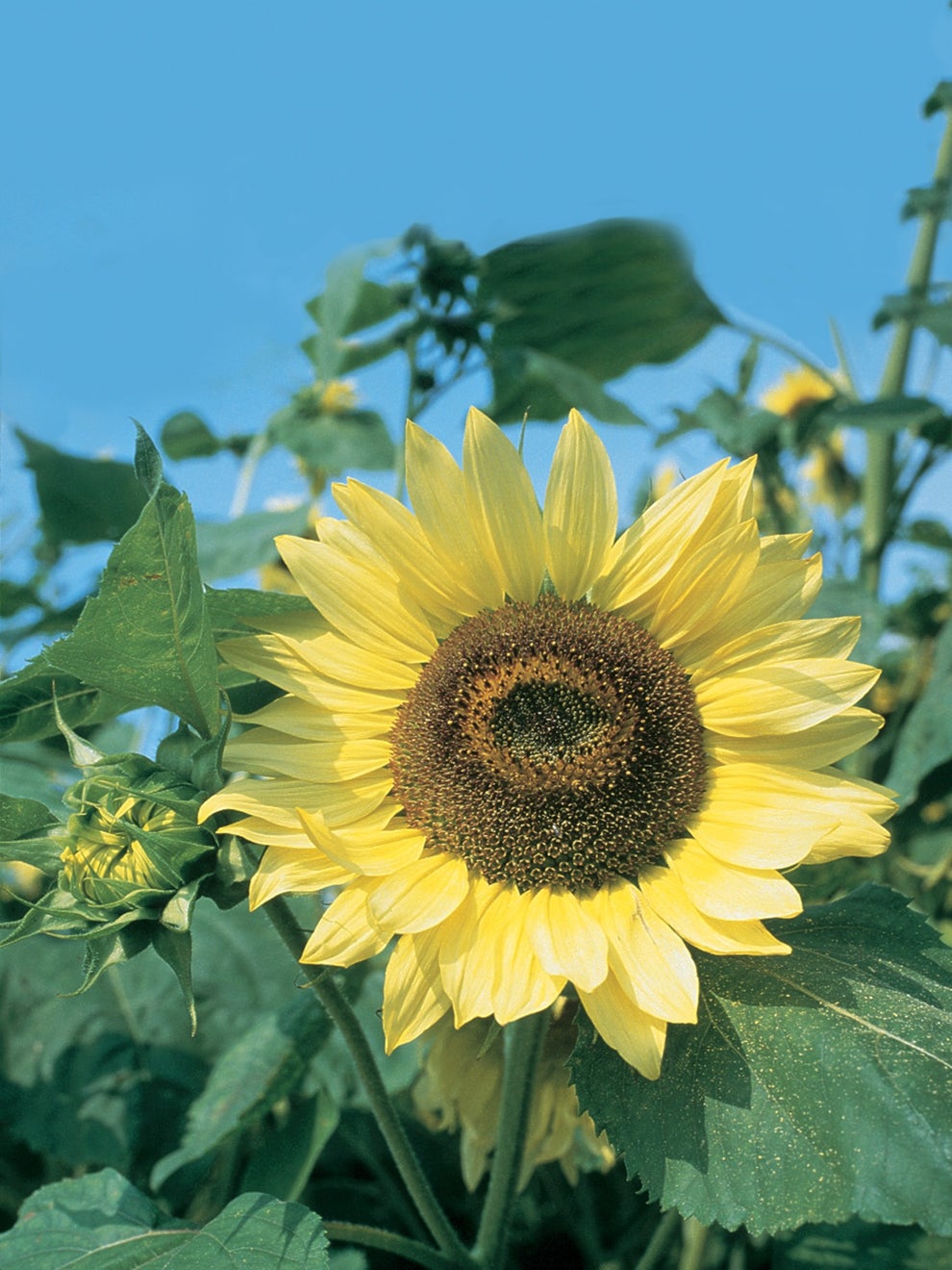
Fun N Sun Blend Sunflower Seeds:
Description: Designer blend of unique varieties! Our designer blend will show you why everybody’s so excited about sunflowers. You get singles and fluffy doubles. Some blooms are a hefty 8", some only 3". There are wine reds, rich golds, soft yellows, white chiffon and bicolor, too. They’ll last 7 days in vase. Abundant blooms for well over 2 months! Attracts butterflies.

Description: An easy way to fill your home with bouquets that will radiate a warm, sunny glow. A treasure in the garden! Fiery, bicolor, 5" diameter sunflower with yellow and deep orange-red blooms are perfect for cut flower arrangements. An easy way to fill your home with bouquets that will radiate a warm, sunny glow. Pair with ‘Sallyfun Blue Emotion’ salvia for a fabulous display in a vase.
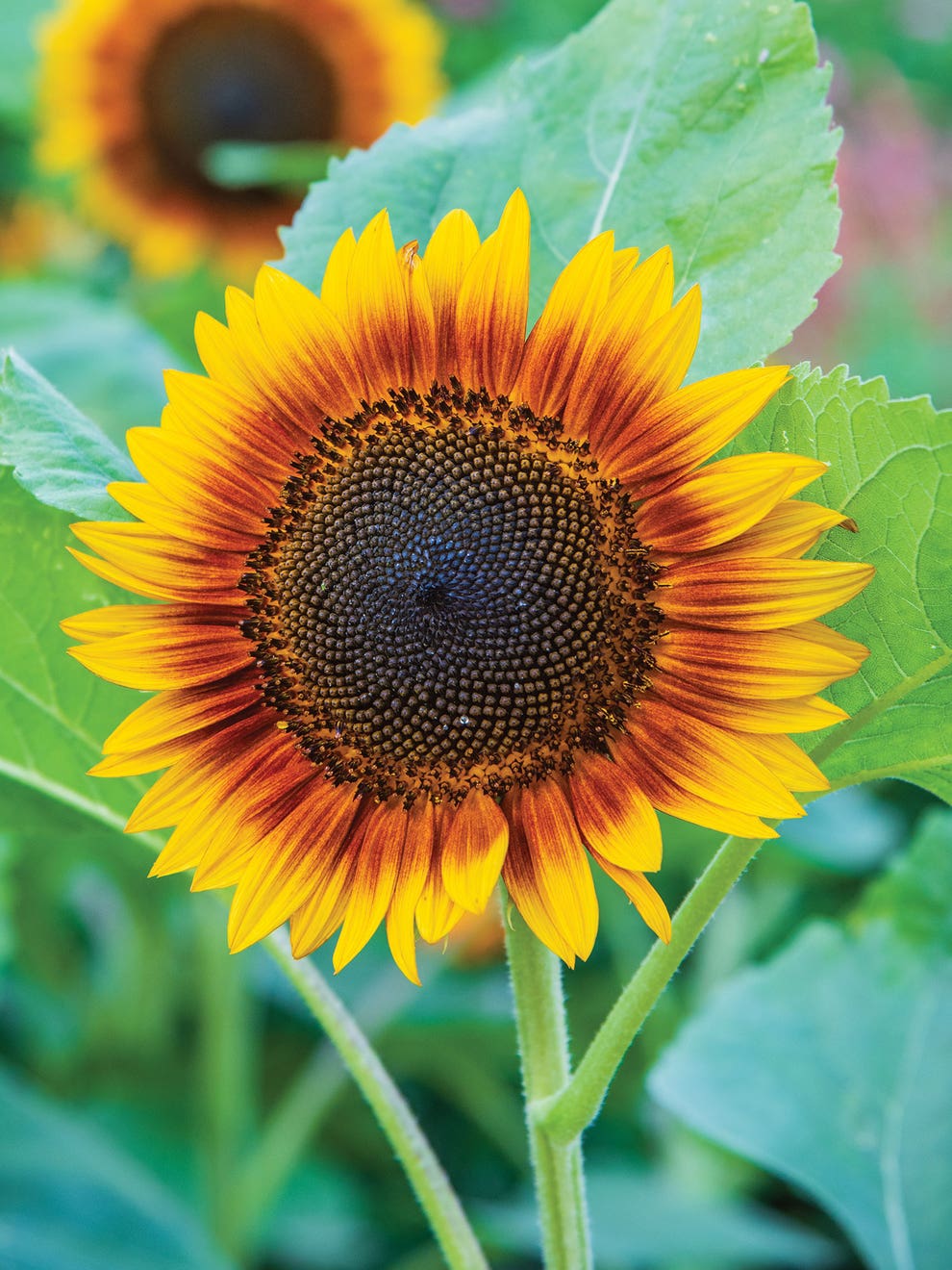
Description: Standout variety with dark-red-to-purple flowers, leaves and stems. One uncommonly gorgeous sunflower! Standout variety’s flowers, leaves and stems are suffused with dark-red-to-purple hues. Low-growing, vigorously branching flame-type 20-30” tall sunflower’s merlot-colored ray petals transition to a pretty pink. Full sun.

Sun-Fill Green Hybrid Sunflower Seed:
Description: Cut flowers early before petals form for a dramatic addition to bouquets. Flower arrangement enthusiasts will be all over this unique selection! The colorful corona of the calyx—the spiky leaves at the base of the flower—is the show here. Like something out of a reverie, this delightfully unique sunflower will entice kids and adventurous gardeners. Cut flowers early before petals form for a dramatic addition to bouquets. Blooms are 3-4" in diameter.

American Giants Hybrid Sunflower Seeds:
Description: One of the tallest ever! Wow! One of the tallest of our tall sunflowers, American Giants look ready to touch the sun. Growing up to 14 ft., their huge yellow faces grow to 1 ft. wide. Perfect for tall hedges or an instant backyard sunforest.
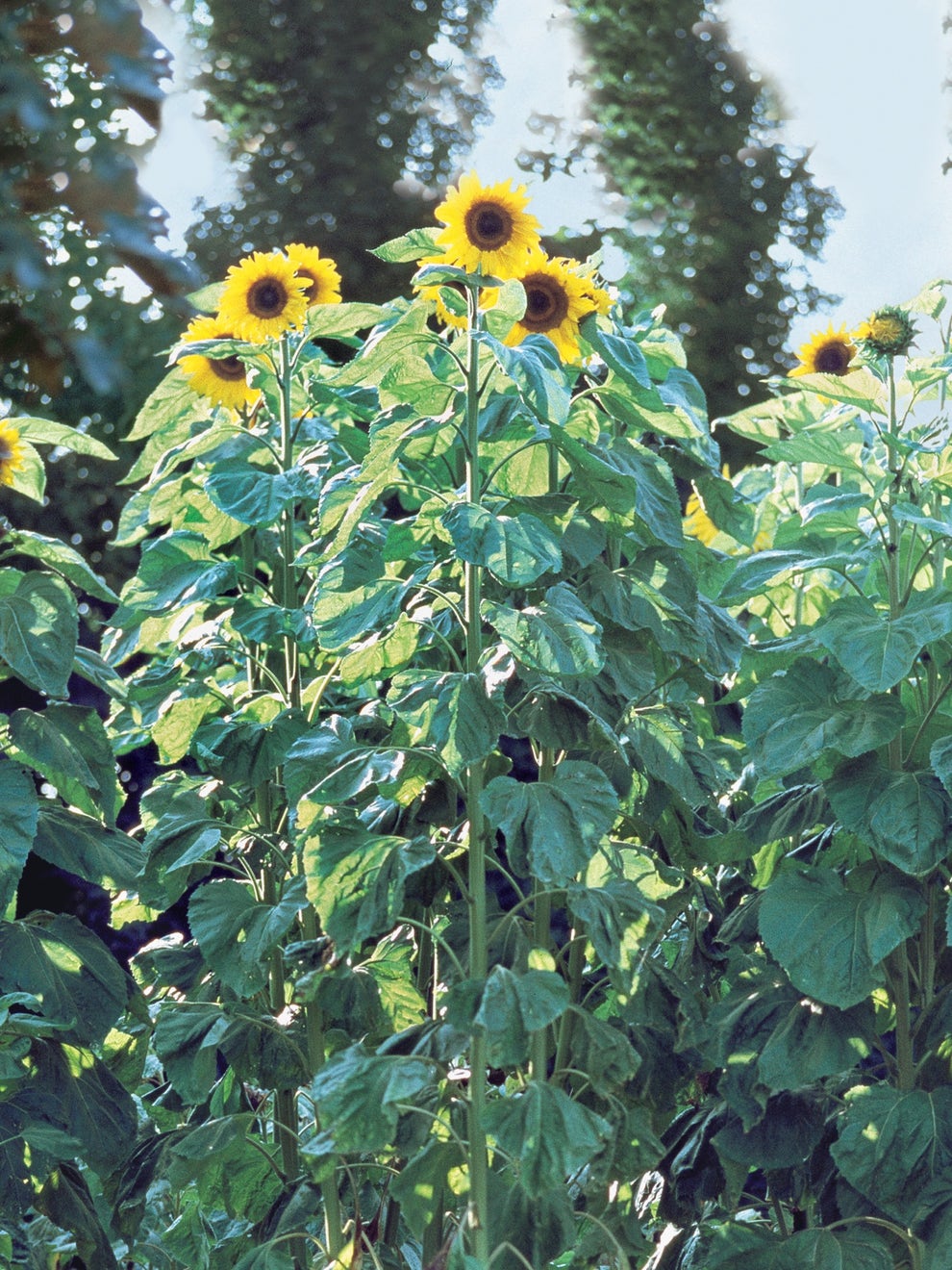
Chocolate Cherry Sunflower Seeds:
Description: Charming sunflower for rustic, one-of-a-kind bouquets. Seductive branching sunflower blooms with a ring of chocolate-burgundy petals around dark chocolate disks. You can’t help but gaze as the velvety petals entice with their dark good looks. Express your style with these alluring beauties, be it rustic, bohemian or wildly natural.

Del Sol Hybrid Sunflower Seeds:
Description: A cheery sunflower-yellow surrounding deep brown centers. Del Sol is extra-early and long-stemmed. Great for cutting, these hybrid sunflowers wont shed on tabletops. Ready to cut for the vase just 50 days after sowing seed.
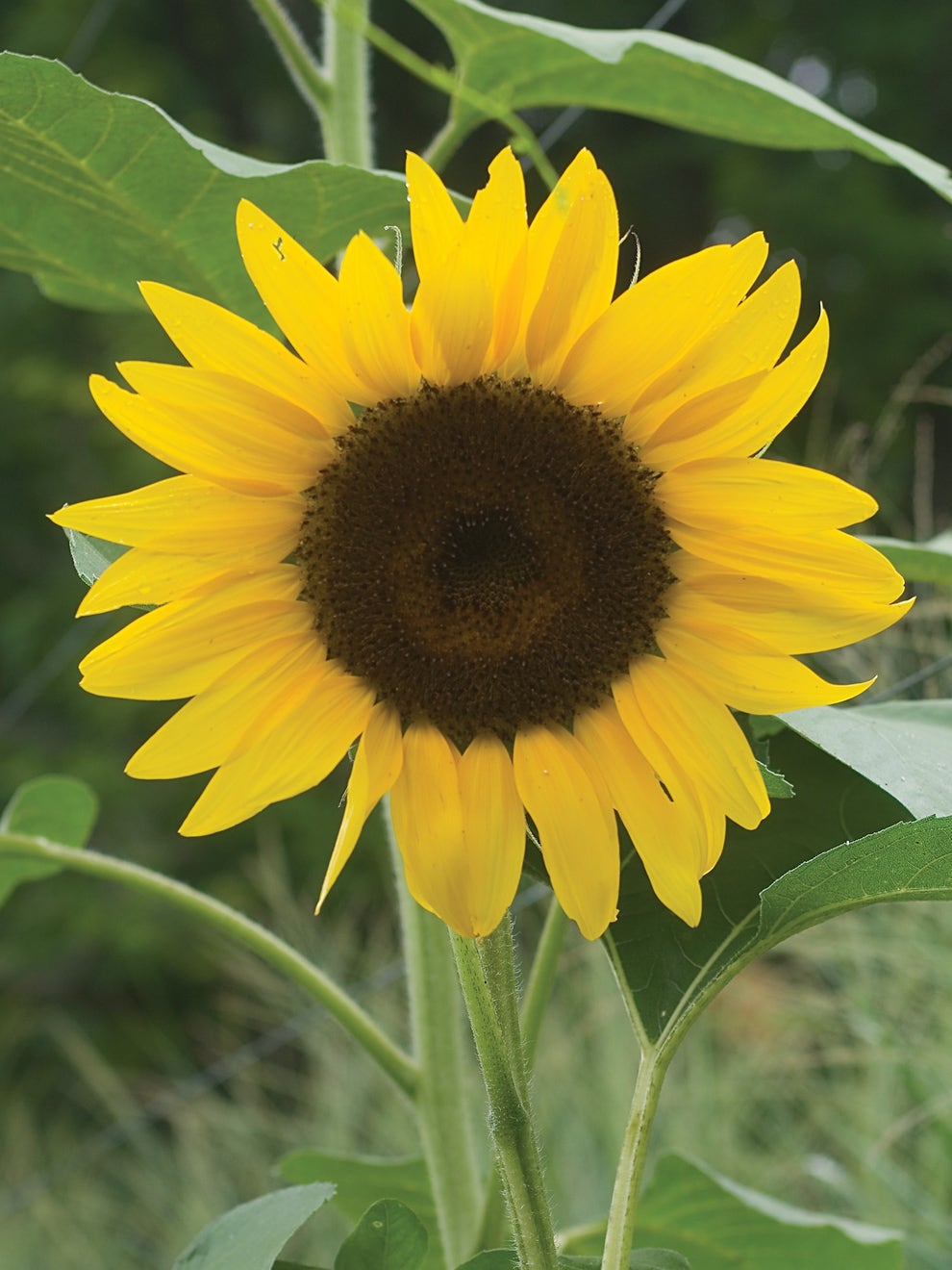
Description: A sunflower as captivating as it is sturdy. A masterpiece for your garden. Radiant beauty stands 4–5 feet tall, with each stem topped by an oversized bloom of bright-yellow petals accented by a lime-colored disc that’s surrounded by a band of florets of the most glorious sunset orange. Strong root system and thick stalks withstand wind and rain. Mesmerizing in bouquets.

Candy Mountain Hybrid Sunflower Seeds:
Description: Flowers and blooms on every leaf node of the 8-10’ plants. Create a home-grown mountain of super-branching 8-10 sunflowers. ‘Candy Mountain’ produces an astonishing display of big, beautiful blooms–burgundy-to-cherry flowers with yellow flames and brown centers- that shoot off in all directions. Every leaf node on these towering plants develops branches, producing single head ‘junior’ plants. ‘Candy Mountain’ adds a vertical spectacle of sensuous color in your landscape. Outstanding cut flowers and excellent choice for small spaces.

Description: The ultimate sunflower for flower power! We’re talking flower POWER! This astonishing sunflower radiates the immense strength of Zeus, most powerful god on Olympus. Glowing lemon-yellow fully-double flower heads, 8–12 across, shine like suns, telegraphing energy and light across the landscape. ‘Zeus’ rises to a massive 8 high, the floral commander!

Description: Soft, fluffy, cushion-like flowers on shorter bushy plants. Golden yellow fully double 6in. blooms, well-suited for mid borders, containers and bouquets. Uniform bush-like plants flower mid-summer on. GARDEN HINTS: Ripe heads are attractive to birds. Cultivate or mulch to control weeds.
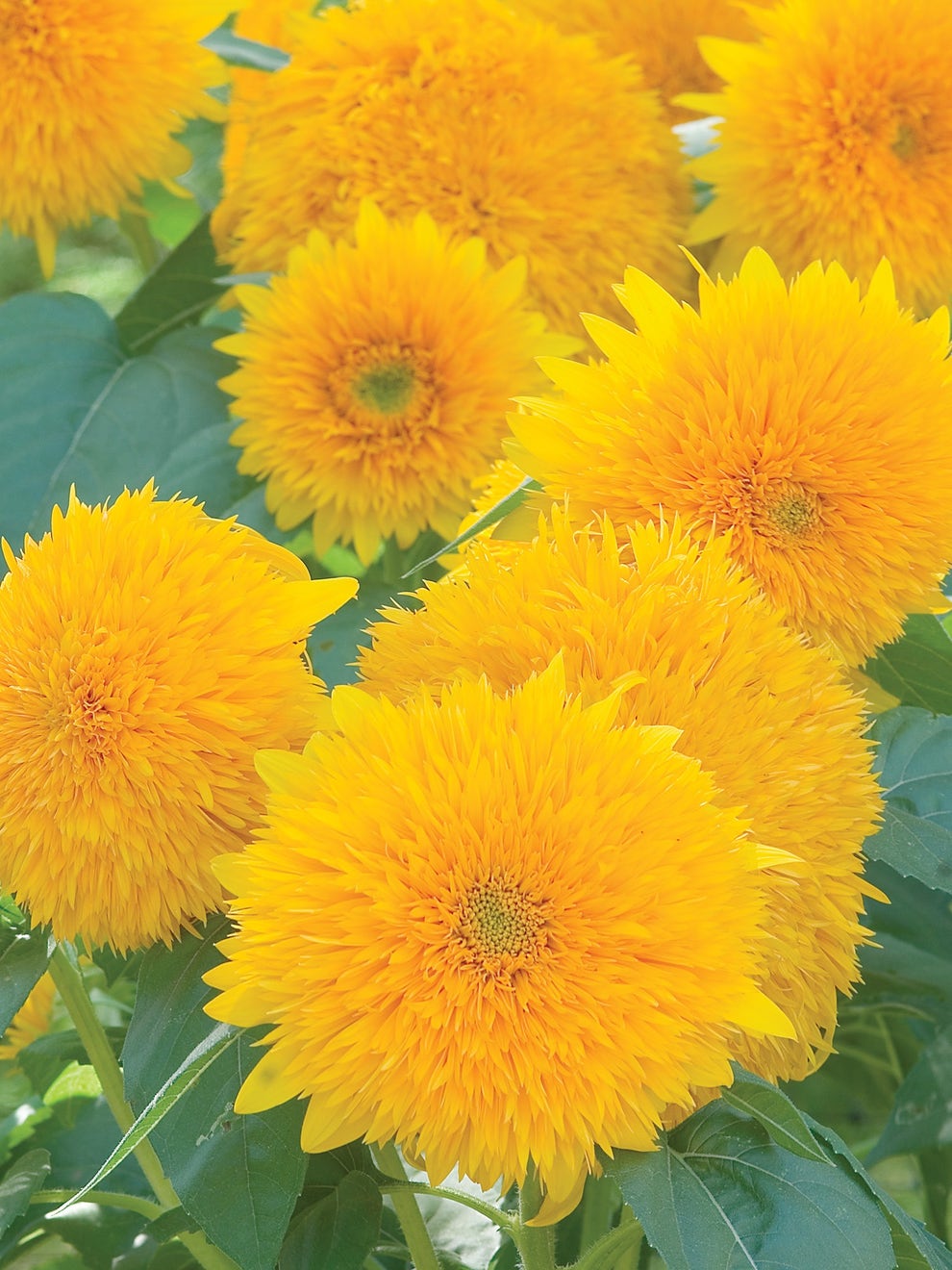
Sun-Fill Purple Hybrid Sunflower Seeds:
Description: Cut flowers early before petals form for a dramatic addition to bouquets. Flower arrangement enthusiasts will be all over this unique selection! The colorful corona of the calyx—the spiky leaves at the base of the flower—is the show here. Like something out of a reverie in green or purple, this delightfully unique sunflower will entice kids and adventurous gardeners. Cut flowers early before petals form for a dramatic addition to bouquets. Blooms are 3-4" in diameter.
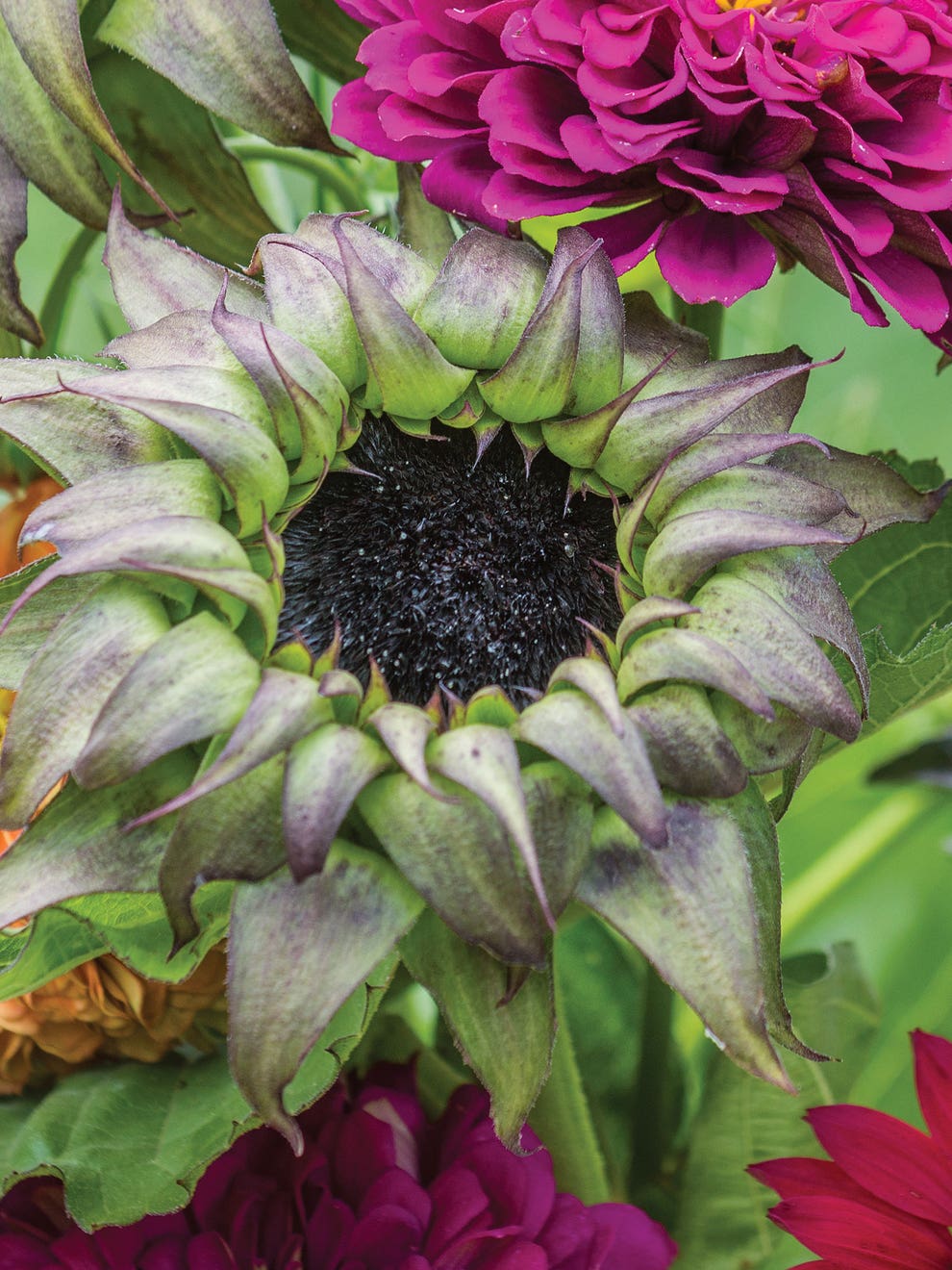
Strawberry Blonde Hybrid Sunflower Seeds
Description: The first rose-pink sunflower! You’ve never seen a sunflower with colors like this! Our first-ever rose-pink sunflower! It is absolutely stunning in vases and the garden. Its combination of subtle lemon and rose-pink flowers surrounding a dark disc, forming 5-6" blooms, will leave you breathless. The plants are well branched for cutting and pollen free so they won’t stain your furniture. Grow in average well-drained garden soil in full sun. Strawberry Blonde grows to 6 ft. tall, so make sure you select the right spot so as to not shade other sun loving plants.
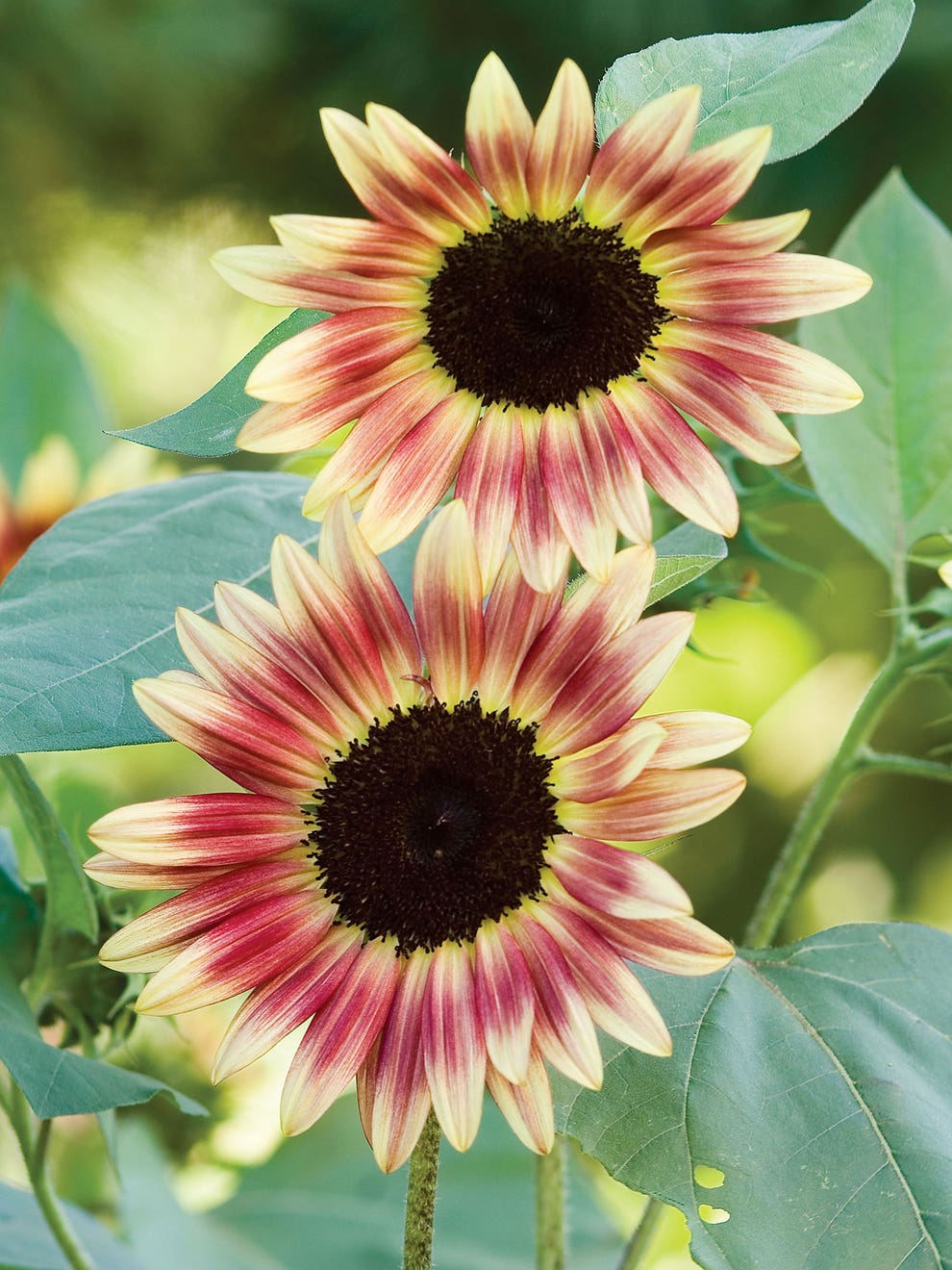
Description: One of the prettiest, sunniest faces we've ever seen in our sunflower garden. These precious beauties have incredibly lovable faces. Soft, furry, golden yellow double flowers are dramatically ringed with single, light yellow ray petals. Growing 5-6 ft. tall, with long-legged elegance, Honey Bear creates distinctive mass plantings, striking hedges and attractive screens for kitchen gardens. Stems are thick, erect and sturdy.

Treasure Mountain Hybrid Sunflower Seeds:
Description: Color-saturated blooms make for dazzling cut flowers, a single vase illuminating your dining room. Madly floriferous, densely branching sunflower fires up a radiant blaze of blooms. Vigorous, long-flowering Treasure Mountains plants produce 10-12 stalks shimmering with 8-10 inch golden-yellow petaled flowers with expressive big brown eyes. Color-saturated blooms make for dazzling cut flowers, a single vase illuminating your dining room. Thanks to extended flowering time and flower-packed habit, a swathe of sunflowers forms a luminous wall of gold as a background planting in sun-soaked sites. Wide spacing ensures fullest branching.
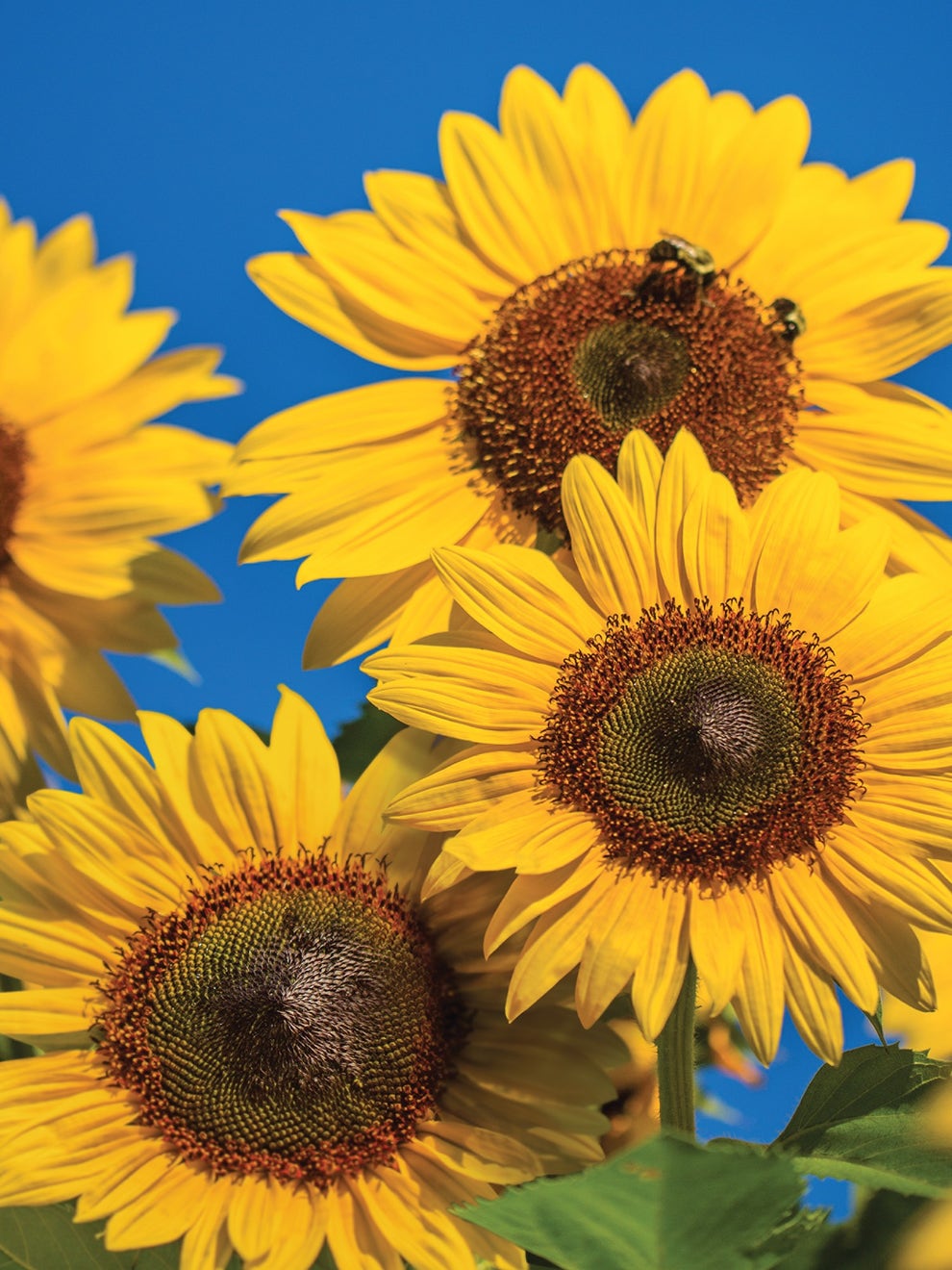
Description: Compact sunflower with big-time flower power. Smaller plants with big-time flower power. Striking compact, low-growing sunflower fills vase after beautiful vase with luminous, long-stemmed, brown-eyed, golden flowers. Heavy-branching, floriferous 20-30” tall plants will keep your home aglow with joyous blooms. Drought-resistant. Full sun.
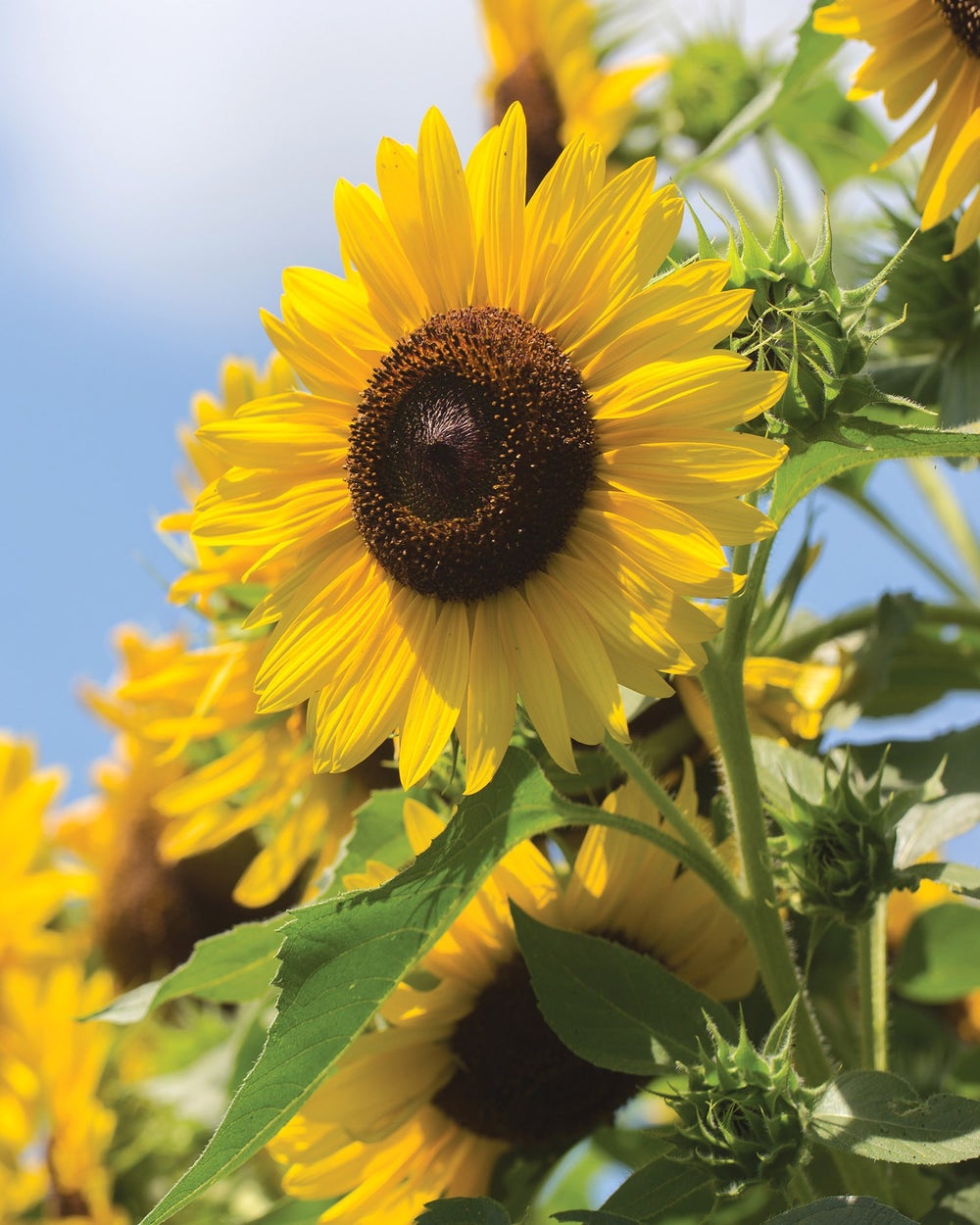
Autumn Beauty Mix Organic Sunflower Seeds:
Description: Organic mix of striking sunflowers. A striking mix of sunflowers in warm shades of orange, yellow, bronze and red. Multi-branched plants provide dramatic contrast as a tall border in flower and vegetable gardens. Blooms are strong-stemmed and 4-6" across, an excellent choice for cut flowers. Provide full sun and well-drained soils. Certified Organic.
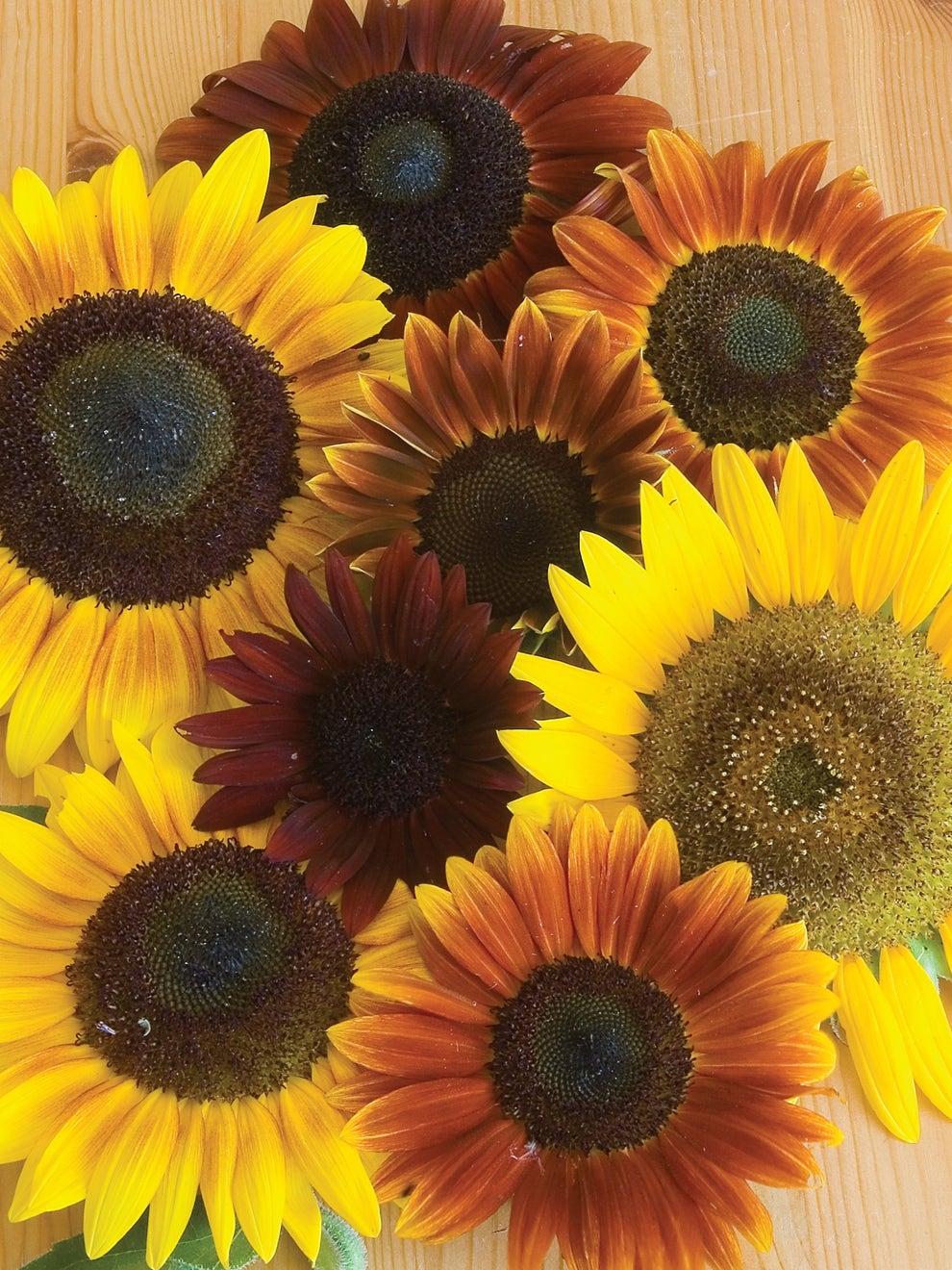
Italian White Sunflower Seeds:
Description: Branching plants with creamy light yellow flowers. Flowers are a luminous, light creamy yellow with attractive dark center eyes. Blooms are produced in abundance on branching plants. Ideal for borders and cut flowers.
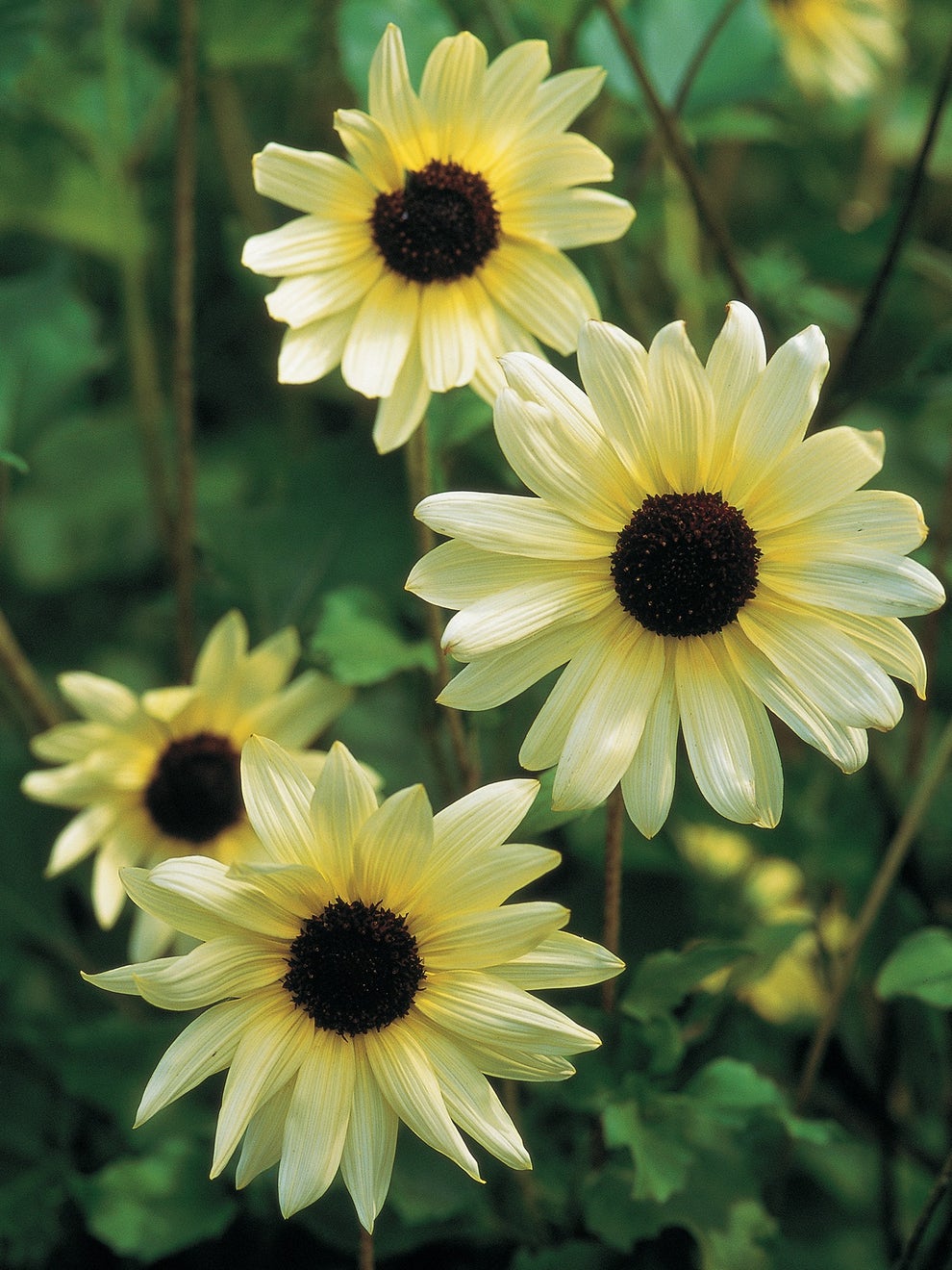
Crimson Blaze Sunflower Seeds:
Description: Bicolor sunflower dazzles with sensuous, high-definition color and outright drama. Outstanding bicolor sunflower dazzles with sensuous, high-definition color and outright drama. Wine-red ray petals tipped in rich yellow orbit dark center disks packed with 600 tiny flowers. Massed in a border or a choice sunny spot, hardy, multibranching 5-6’ plants exude chromatic pizzazz. Mingles marvelously alongside other disc flowers with bright yellow centers. Produces vase after gorgeous vase of cut flowers. Easy-growing plants thrive in moist soil. A magnet for color-loving bees, birds, and butterflies.

Description: Dense, hedge-like sunflower only 3 feet tall! Densely branched, dwarf hedge to 3 feet tall, topped by large 7" sunflowers. Very distinctive flower form, with double rows of bright yellow ray petals surrounding the dark center disc. Perfect addition for sunny borders and for fresh bouquets. For all summer-long supply of cut sunflowers, repeat sowings in containers or directly in garden beds.

Soluna Lemon (Helianthus Debilis) Beach Sunflower Seeds:
Description: Highly salt-tolerant and drought-tolerant plant that thrives in sandy soil in full sun. This Florida native sunflower is a butterfly magnet perfect for use in hot, dry and moderately saline gardens. Also known as ‘cucumberleaf’ sunflower it is native to the United States, where it can be found along the Atlantic and Gulf Coasts. This east coast dune sunflower is fast-growing and highly salt-tolerant plant that thrives in sandy, well-drained soil in full sun. Helianthus debilis blooms almost year-round with lemon, daisy-like or sunflower-like flowers that have yellow petals and brown centers. Because of their year-round flowering, these plants can be especially good for brightening up the landscape during the warm and cool temperature extremes during the year. This plant is used as a garden flower. It is also good for landscaping, especially in poor, dry soils.

ProCut White Lite Sunflower Seeds:
Description: Excellent white cut-flower mixes well in bouquets. Cream petals brighten to white and surround a honey-colored center on this unique new sunflower. Excellent cut-flower variety is pollenless, with one 3-5” bloom per plant on strong, sturdy stems.

ProCut White Nite Sunflower Seeds:
Description: Crisp, fashionable white petals surround a dark center. Cream petals mature to white and contrast beautifully with the dark brown center on this high-quality sunflower. Excellent cut-flower variety is pollenless, with one 3-5” bloom per plant on strong, sturdy stems.

Description: The largest sunflower seeds ever. Plants tower up to 15 ft. tall. The sunflower that sunflowers look up to, with the largest sunflower seeds in the world. Ginormous seed heads house seeds as large as 1 1/2 long, the biggest weve ever seen. Extra-large seeds mean extra-large plants, and these grow 12-15 with luminous 14 golden-yellow flowerheads.
